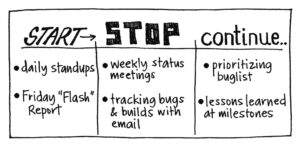With a fresh new year to start, it is time to set the stage for Q1 of 2022! Here is how a typical team session agenda could look like:
- Good news – Sharing professional and personal achievements and general good news
- Retrospect – What do we find challenging / can we do better + reflecting on previous quarters’ achievements
- Start / Stop / Continue – What new initiative should start, what should stop, and what should continue?
- Goal setting – By the end of Q1, we would like to have…
- Q1 individual goals – In the next quarter, what one thing would you like to achieve
- Any other business
Preparation doesn’t take a ton of time, but I learned, it helps to structure it like this:
1. Prep – 10 min.
During COVID times, for remote teams, start by creating a collaboration document, like a Trello board, a Confluence page, or just simply a Google Docs file. Share this ahead of the team’s session.
For in-person sessions, create a collaboration document to share on a screen during the session. As a team, decide what period of time you’re setting goals for. Quarterly goals are usually a good start.
I advise to share any information that will help inform the goals with the team before the session. This could include broader company goals (always start with sharing the big picture), project roadmaps, customer metrics, customer feedback, or previous quarters’ goals. Even recent customer issues could lead to interesting new learnings and thus goals.
2. Set the stage – 5 min.
Ask the team to remember the following before starting the meeting: It’s important to think of the value we want to achieve for our customers, clients, or people we serve.
The team should consider how to measure success towards achieving that value.
I usually find it really interesting to start and to set the tone by reflecting on previous quarters’ achievements and sharing good news from that. Starting with a retrospective can also really work well.
3. Choose goals – 30 min – 2 hours
Pose the question, “Where can we bring the most value to our customers in the upcoming quarter?”, or use the method, “Start / Stop / Continue” to find out what interesting new initiatives arise (or how to free up time to stop initiatives that don’t contribute to the bigger picture).

Have the team brainstorm objectives by adding them to the collaboration document. Group similar objectives together, then summarize the ideas into SMART goals for the quarter. These can be individual goals or goals for the entire team. Assign each goal to a team member. Agree together that the assignee is responsible for tracking the progress on the objective. Reporting can be done on an individual basis in 1:1 sessions. In the next quarter, I usually reflect on previous quarters’ achievements too.
4. Set Key Results – 5 – 30 min.
For each goal, decide on a few key results that, when reached, would confirm you’ve achieved the goal. Ensure the team is choosing metrics that demonstrate the result of the work the team has done.
6. Review 10 – 30 min.
Review your goals and key results and ask each other whether they’re ambitious enough. Balance setting achievable goals with creating enough of a challenge to keep the team motivated. Ensure the goals can be judged periodically. The outcome can be:
- We missed the mark
- We came very close
- We knocked it out of the park. Maybe we should set harder objectives moving forward.
